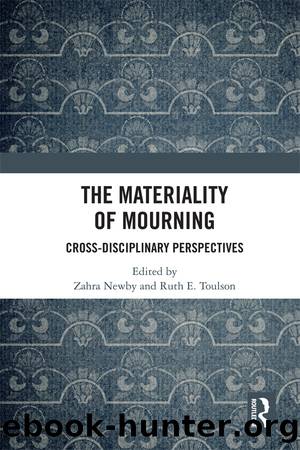The Materiality of Mourning by Zahra Newby Ruth Toulson

Author:Zahra Newby, Ruth Toulson [Zahra Newby, Ruth Toulson]
Language: eng
Format: epub
ISBN: 9780367588434
Barnesnoble:
Publisher: Taylor & Francis
Published: 2020-06-30T00:00:00+00:00
Figure 7.4âWomanâs bust, c. 180â200 CE (reworked from an earlier second century womanâs bust), Weiden tomb.
Photo: courtesy of the Römisch-Germanisches Museum der Stadt Köln/RBA 158080.
Figure 7.5âFemale bust, c. 100â150 CE (reworked from an ideal piece of sculpture), Weiden tomb.
Photo: courtesy of the Römisch-Germanisches Museum der Stadt Köln/RBA 94531.
To understand the function of these portraits and how they were viewed in antiquity, it is necessary to consider their tomb context. Remarkably the bust portraits were discovered in context in the tomb chamber, the two womenâs busts positioned in their original display niche. The tomb itself consisted of a roughly square chamber entered via a tufa staircase on its east side. This space was defined by three large rectangular alcoves on the north, west and south sides. The walls and alcoves are defined by smaller niches (29 in total), which give the chamber the appearance of a columbarium. However, the evidence of only two burials and the shape of the niches indicate that these were intended to display donations and sacrifices.55 Similarly, the limited (if high quality) sculptural and ceramic remains and lack of inscriptional evidence are more indicative of an intimate family tomb, which perhaps belonged to a nearby, elite country villa.56
As mentioned briefly above, the bust of the Severan date woman and that of the ideal fragment reworked into a bust were found intact and upright in the south alcove of the chamber (Figure 7.6).57 The male bust, dislodged during the destruction of the tombâs roof, was found in the fill on the floor of the chamber. However, it is likely that this would have been positioned (as the bust of it is now) in the alcove facing the female busts on the north wall. In this way male and female busts, most probably husband and wife, would have gazed across to one another acting as pendants. This arrangement allowed the connection between the portraits to be confirmed, thus asserting the perseverance of their relationship after death. The identity of the third âidealâ portrait bust is difficult to assert with any certainty. The earlier bust form may either suggest that this portrait belonged to an earlier phase in the tombâs display or that it was moved into the burial chamber, from another location, at the time of the other two bustsâ introduction. Either way its display context, sharing a niche with the other female bust portrait, suggests the desire to create a relationship between all three busts. This ideal bust then was probably intended to function as a stand-in for another family member commemorated in the tomb.
The only furniture found in the tomb were two limestone âwicker effectâ tub chairs. Although many funerary reliefs depict the deceased seated or reclining, and the exterior of some tombs include benches to encourage passers-by to stop and consider the deceased, finding substantial pieces of furniture in the tomb itself is rare.58 We may wonder what the purpose of these tub chairs was. Were they symbolic, designed to accommodate the deceasedâs final resting place,
Download
This site does not store any files on its server. We only index and link to content provided by other sites. Please contact the content providers to delete copyright contents if any and email us, we'll remove relevant links or contents immediately.
Cecilia; Or, Memoirs of an Heiress — Volume 1 by Fanny Burney(32437)
Cecilia; Or, Memoirs of an Heiress — Volume 2 by Fanny Burney(31873)
Cecilia; Or, Memoirs of an Heiress — Volume 3 by Fanny Burney(31857)
The Great Music City by Andrea Baker(31516)
We're Going to Need More Wine by Gabrielle Union(18972)
All the Missing Girls by Megan Miranda(15588)
Pimp by Iceberg Slim(14398)
Bombshells: Glamour Girls of a Lifetime by Sullivan Steve(13977)
Talking to Strangers by Malcolm Gladwell(13231)
Norse Mythology by Gaiman Neil(13211)
Fifty Shades Freed by E L James(13161)
For the Love of Europe by Rick Steves(13071)
Mindhunter: Inside the FBI's Elite Serial Crime Unit by John E. Douglas & Mark Olshaker(9206)
Crazy Rich Asians by Kevin Kwan(9171)
The Lost Art of Listening by Michael P. Nichols(7411)
Enlightenment Now: The Case for Reason, Science, Humanism, and Progress by Steven Pinker(7239)
The Four Agreements by Don Miguel Ruiz(6637)
Bad Blood by John Carreyrou(6558)
Weapons of Math Destruction by Cathy O'Neil(6149)
